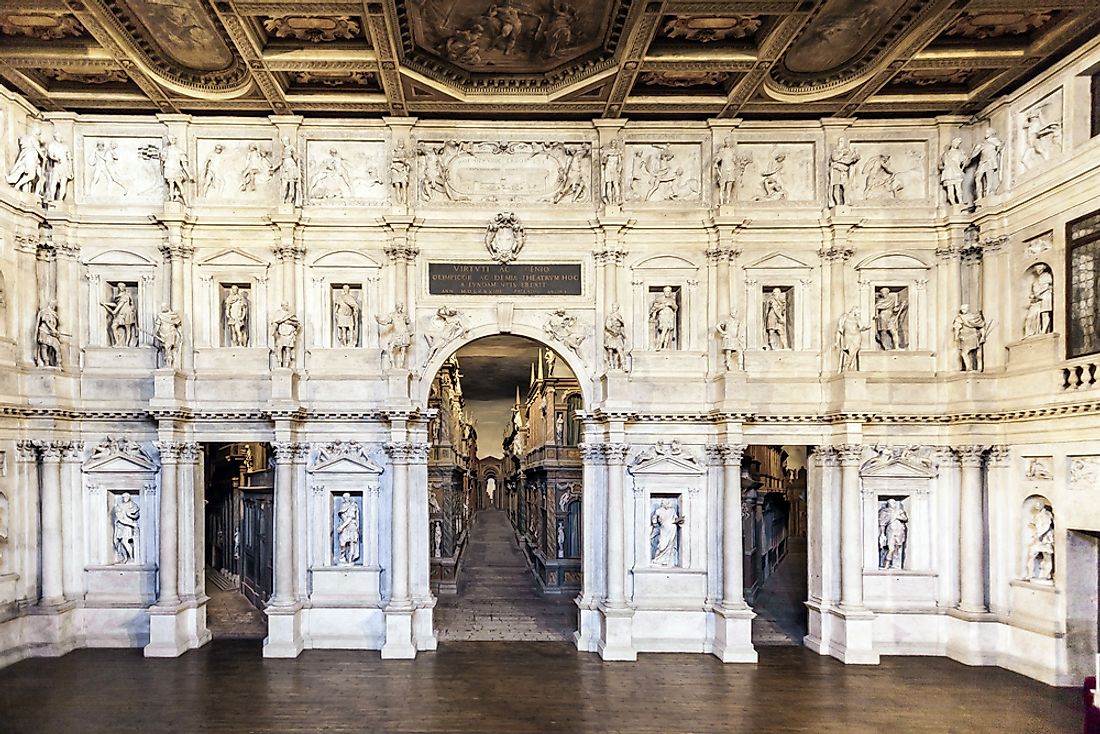Which Is The Oldest Theater In The World?

- Teatro Olimpico was commissioned towards the end of the 1570s by the Vicenza Olympic Academy.
- The Teatro Olimpico took about five years for construction to be completed and was inaugurated on March 5th, 1585 with a performance of Sophocles’s Oedipus the King.
- The original architect behind the theatre unexpectedly died, and never got to see the finished project of his vision.
The Teatro Olimpico, which translates to Olympic Theater, in Vicenza, Italy is considered to be the oldest theater in the world, having hosted its first performance in 1585. It is also considered to be one of the most beautiful theaters in Europe The theater was designed by Andrea Palladio, an Italian architect and a master of Renaissance architecture, as well as a designer of numerous celebrated buildings all over Italy. Teatro Olimpico was the home of the Accademia Olimpico which was founded there in the year 1955.
Design of Teatro Olimpico
Teatro Olimpico was commissioned towards the end of the 1570s by the Vicenza Olympic Academy. Since Palladio was a renowned local architect and one of the academy’s founders, he was the obvious choice for the job of providing designs. By 1580, work on the ornate structure had already started but came to an abrupt stop as a result of Palladio’s unexpected death. Vicenzo Scamozzi, a Venetian architect, took over the project thus working from Palladio’s intricate drawings. When the Maestro died, the theater’s interior design had already been finalized, so Scamozzi only provided designs for the auditorium and the stage. Scamozzi’s designs featured an awe-inspiring stage set and trompe l’oeil backdrop giving the impression of a three-dimensional building and streets. The innovative architect also invented a way of lighting individual rooms to further suggest perspective and depth.
History of Teatro Olimpico
The Teatro Olimpico took about five years for construction to be completed and was inaugurated on March 5th, 1585 with a performance of Sophocles’s Oedipus the King. Despite the theater’s grandeur stature, it was abandoned after only several productions. Despite the magnificence of the theatre it was hardly used after it was inaugurated, and this could be the reason why it remained preserved to date. Since Scamozzi’s original lighting system of glass oil lamps increased the risk of fire and was costly, it has not been used much. However, in 1997, when Teatro Olimpico was again used for the production of Oedipus the King, they used the lighting system designed by Scamozzi. In recognizing the theater’s excellent state of preservations as well as its significance to the Renaissance world of architecture, in 1994, Teatro Olimpico was named a UNESCO World Heritage Site.
Modern-day Operation of the Theater
Even though Scamozzi finished the design for Teatro Olimpico, the theater remains a towering example of Palladio’s architectural genius. At present, Teatro Olimpico is the world’s oldest surviving theater that is enclosed. Even though it is still used for musical performances and plays, access to the theater is limited due to this ancient building’s fragile state. Therefore, the size of the audience in the theater is kept to a minimum with the auditorium only accommodating 400 seats. In Teatro Olimpico, performances take place in two theater seasons, for instance, the Il Suono dell'Olimpico festival takes place during spring season while classical plays take place during autumn. The theater is not installed with any air or heating conditioning system since it could potentially destroy the delicate wooden structures. Teatro Olimpico is also used by the American Department of Defense high school located in Vicenza for graduation ceremony purposes every June. In 2005, the theater was used as a filming location for the movie Casanova, while in 1979 it was used for the filming of Don Giovani.











